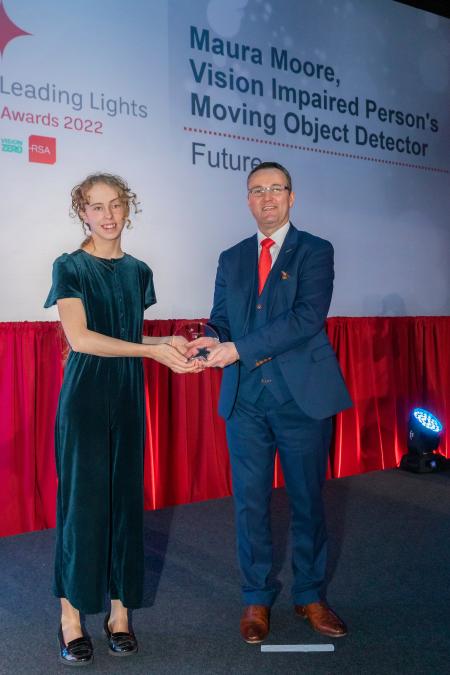Our members are dedicated to improving road safety and sharing their knowledge with the wider community. Here, you can explore our members' good practices – initiatives that have been assessed for their effectiveness in addressing a road safety problem and have proven results.
Get inspired – and sign up to share your good practices too!

Friday, May 26, 2023
In Belgium, as in Europe and large parts of the Western world, life expectancy is ever increasing. While this "aging" is made possible by very comprehensive preventive or curative health care, this certainly does not eliminate all the cognitive or motor impairments associated with aging. In addition, older people are also becoming increasingly mobile, and more specifically, they are using their own vehicle or car up to a higher age.
As people age, two risks that are often used in the context of road safety become important:
- Accident risk: the likelihood to be involved in an accident.
- Injury risk: the likelihood of injury, given an accident has occurred.
With this product, the senior selfTest, we focus on the triggers for accident risk with senior drivers.
Safe participation in traffic, in the context of an ageing population, presupposes two things: "driving skills" and "fitness to drive". Driving skills are strongly linked to learning processes, gaining experience, vehicle control and traffic insight. Fitness to drive has more to do with the physical and mental abilities of the driver: health, sensory and cognitive abilities, influence of alcohol, drugs or medication, etc.
Older road users usually have a very extensive mobility and traffic experience, and associated with that generally overall good driving skills. However, as drivers age, some of the mental and/or physical capacities needed to put those skills to good use gradually decrease. In other words, fitness to drive decreases. Examples are: reduced vision (sharpness, night blindness, etc.), poor hearing, higher reaction times, reduced muscle control or muscle strength, etc.
This decline in capacities is likely to proceed in two speeds. For most people it can be expected that this is a gradual process, which may also be partially absorbable or slowed down. Barring sudden illness and accidents, the decline in physical or mental functionality is a process of several decades. However, when looking at the oldest age categories, it can be expected that a quicker decrease in physical or mental functionality occurs as a result of (a higher likelihood of) more grave illnesses.
Although road users compensate for this natural decline in capacities to some extent (e.g. by driving less at night, driving slower, etc.), there is still a general risk that one's own skills and fitness to drive will be overestimated, or that a decline in skills and suitability will eventually go too fast. In other words, if a self-regulating compensation mechanism is used, it may not be enough to continue to drive “safely”. Different supporting measures need to be developed if we wish senior drivers to truly remain independently safely mobile.
With the SelfTest we present a product that aims at increasing awareness with senior drivers on the importance of psycho-cognitive factors and their own capacities in relation to accident risk, and therefor safe and comfortable driving.
The SelfTest, its development and use is described in the paragraph “project activities”.
The relevance towards improving road safety, compared to other actions taken to support safe driving by senior drivers, is described in the paragraph “evaluation”
As people age, two risks that are often used in the context of road safety become important:
- Accident risk: the likelihood to be involved in an accident.
- Injury risk: the likelihood of injury, given an accident has occurred.
With this product, the senior selfTest, we focus on the triggers for accident risk with senior drivers.
Safe participation in traffic, in the context of an ageing population, presupposes two things: "driving skills" and "fitness to drive". Driving skills are strongly linked to learning processes, gaining experience, vehicle control and traffic insight. Fitness to drive has more to do with the physical and mental abilities of the driver: health, sensory and cognitive abilities, influence of alcohol, drugs or medication, etc.
Older road users usually have a very extensive mobility and traffic experience, and associated with that generally overall good driving skills. However, as drivers age, some of the mental and/or physical capacities needed to put those skills to good use gradually decrease. In other words, fitness to drive decreases. Examples are: reduced vision (sharpness, night blindness, etc.), poor hearing, higher reaction times, reduced muscle control or muscle strength, etc.
This decline in capacities is likely to proceed in two speeds. For most people it can be expected that this is a gradual process, which may also be partially absorbable or slowed down. Barring sudden illness and accidents, the decline in physical or mental functionality is a process of several decades. However, when looking at the oldest age categories, it can be expected that a quicker decrease in physical or mental functionality occurs as a result of (a higher likelihood of) more grave illnesses.
Although road users compensate for this natural decline in capacities to some extent (e.g. by driving less at night, driving slower, etc.), there is still a general risk that one's own skills and fitness to drive will be overestimated, or that a decline in skills and suitability will eventually go too fast. In other words, if a self-regulating compensation mechanism is used, it may not be enough to continue to drive “safely”. Different supporting measures need to be developed if we wish senior drivers to truly remain independently safely mobile.
With the SelfTest we present a product that aims at increasing awareness with senior drivers on the importance of psycho-cognitive factors and their own capacities in relation to accident risk, and therefor safe and comfortable driving.
The SelfTest, its development and use is described in the paragraph “project activities”.
The relevance towards improving road safety, compared to other actions taken to support safe driving by senior drivers, is described in the paragraph “evaluation”

Friday, May 26, 2023
Los siniestros viales son una cuestión relevante de seguridad y salud pública. De los tres factores de siniestralidad (factor humano, factor vehículo y factor entorno), el que aparece con mayor frecuencia entre las causas del siniestro es el humano, presente en entre un 70% y un 90% de los casos. Estudiando las principales cifras de la siniestralidad vial, se observa el peso de algunos de estos factores en los resultados de los siniestros. Si tenemos en cuenta la edad, las personas más jóvenes y las mayores tienen mayor riesgo de fallecer, y en función del sexo, los hombres presentan un mayor riesgo para todas las edades. A igual nivel de exposición, la presencia de conductas de riesgo supone una mayor probabilidad de siniestro y de lesiones (por ejemplo, menos uso de elementos de seguridad o velocidad excesiva.). El proceso de envejecimiento (la suma del deterioro psicomotor, enfermedades y consumo de fármacos) y la aparición de enfermedades o discapacidades a cualquier edad incrementa el riesgo de que ocurra un siniestro vial.
La morbilidad clásicamente se ha considerado responsable de la pérdida o el deterioro de las aptitudes psicofísicas de las personas que conducen. Sin embargo, el estudio de las enfermedades como factor de riesgo de siniestro es muy complejo, debido a la gran cantidad de variables que intervienen en la causalidad del mismo (tipo de vehículo, condiciones ambientales, estado de mantenimiento del vehículo o tipo de vía) y a otros factores como el número de kilómetros recorridos, etc., que con frecuencia no son tenidos en cuenta. No todas las enfermedades se consideran un factor de riesgo de siniestro, ni todas se asocian al mismo nivel de riesgo; además, generalmente, cuando la enfermedad está controlada y existe un buen cumplimiento del tratamiento el riesgo se reduce considerablemente.
Las diferencias en la forma de presentación de una enfermedad entre unas personas y otras, el momento evolutivo, la respuesta al tratamiento, el tipo de fármaco empleado, la asociación a otros problemas (consumo de alcohol, otras sustancias, etc.), hacen necesaria la valoración de la aptitud de las personas que conducen de forma individualizada.
España cuenta con un sistema de Centros de Reconocimiento de Conductores. En 2022, se expidieron en España casi 800.000 permisos, y se renovaron 3,3 millones. Una correcta exploración médica-psicológica resulta fundamental para disminuir los riesgos asociados a la pérdida de aptitudes psicofísicas. Con este fin, en 2022 se actualizó el protocolo de exploración médico-psicológica, incorporando las nuevas evidencias científicos y los nuevos métodos desarrollados desde el anterior protocolo de 2007. El nuevo protocolo puede encontrarse en: https://www.dgt.es/export/sites/web-DGT/.galleries/downloads/nuestros_servicios/Protocolo-de-exploracion-medico-psicologica-para-centros-de-reconocimiento-de-conductores_2022.pdf
La morbilidad clásicamente se ha considerado responsable de la pérdida o el deterioro de las aptitudes psicofísicas de las personas que conducen. Sin embargo, el estudio de las enfermedades como factor de riesgo de siniestro es muy complejo, debido a la gran cantidad de variables que intervienen en la causalidad del mismo (tipo de vehículo, condiciones ambientales, estado de mantenimiento del vehículo o tipo de vía) y a otros factores como el número de kilómetros recorridos, etc., que con frecuencia no son tenidos en cuenta. No todas las enfermedades se consideran un factor de riesgo de siniestro, ni todas se asocian al mismo nivel de riesgo; además, generalmente, cuando la enfermedad está controlada y existe un buen cumplimiento del tratamiento el riesgo se reduce considerablemente.
Las diferencias en la forma de presentación de una enfermedad entre unas personas y otras, el momento evolutivo, la respuesta al tratamiento, el tipo de fármaco empleado, la asociación a otros problemas (consumo de alcohol, otras sustancias, etc.), hacen necesaria la valoración de la aptitud de las personas que conducen de forma individualizada.
España cuenta con un sistema de Centros de Reconocimiento de Conductores. En 2022, se expidieron en España casi 800.000 permisos, y se renovaron 3,3 millones. Una correcta exploración médica-psicológica resulta fundamental para disminuir los riesgos asociados a la pérdida de aptitudes psicofísicas. Con este fin, en 2022 se actualizó el protocolo de exploración médico-psicológica, incorporando las nuevas evidencias científicos y los nuevos métodos desarrollados desde el anterior protocolo de 2007. El nuevo protocolo puede encontrarse en: https://www.dgt.es/export/sites/web-DGT/.galleries/downloads/nuestros_servicios/Protocolo-de-exploracion-medico-psicologica-para-centros-de-reconocimiento-de-conductores_2022.pdf

Friday, May 26, 2023
The main issues our practice addresses are the following:
1. Proper body position on the motorcycle
2. Proper method of braking
3. Proper eye focus while riding
4. Proper motorcycle riding behaviour (other road users)
5. Developing confidence and overcoming fears when on the motorcycle
1. Proper body position on the motorcycle
2. Proper method of braking
3. Proper eye focus while riding
4. Proper motorcycle riding behaviour (other road users)
5. Developing confidence and overcoming fears when on the motorcycle

Thursday, May 25, 2023
The aim of my project is to design a portable device or app to detect fast moving objects.
Approximately 2.2 million people globally are vision impaired.
As a vision impaired person, I have difficulty seeing oncoming vehicles and other hazards, such as electric cars or e-scooters.
For these reasons, I developed VIPMOD: Vision Impaired Person's Moving Object Detector.
Vision impaired people are not the only group of people with this difficulty.
People with other access needs, such as mobility disabilities, or people who are hearing impaired, will also benefit from VIPMOD, helping them to live safer and more independent lives.
Approximately 2.2 million people globally are vision impaired.
As a vision impaired person, I have difficulty seeing oncoming vehicles and other hazards, such as electric cars or e-scooters.
For these reasons, I developed VIPMOD: Vision Impaired Person's Moving Object Detector.
Vision impaired people are not the only group of people with this difficulty.
People with other access needs, such as mobility disabilities, or people who are hearing impaired, will also benefit from VIPMOD, helping them to live safer and more independent lives.

Thursday, May 25, 2023
Classic road safety equipment has always been passive, waiting for drivers to lose control, leave the road and suffer an accident against it. In that moment, they are necessary to contain and redirect the vehicle, as well as to reduce its severity and consequences. However, despite their generalized deployment in our roads, we still face deaths and severe injured.
PLUG&META® technology brings a new paradigm for road equipment, allowing the infrastructure to be proactive, to start talking to users and prevent accidents from happening. It also gathers road safety data and events for the road administration.
It is a digital system that can be integrated both into new or existing equipment, for example guardrails, bridge parapets, noise barriers or acoustic wall cladding for tunnels, crash cushions and others.
This worldwide innovation, patented and fully developed by Metalesa, provides active road safety to infrastructure, that is to say, the connected and smart infrastructure will have the capability to autonomous and continuously identify risks on the road (ex: ice, bad visibility, cyclist/pedestrians/animals on the road, excessive speed...) and activate in real time an adaptative LED signalling system to make drivers aware of the risk, and hence, allowing them to anticipate safer decisions. Thanks to PLUG&META® technology, key variables of risk detection, signalling and data collection can be configured from an open intuitive management platform, called PLUG&META® TRACE.
PLUG&META® technology brings a new paradigm for road equipment, allowing the infrastructure to be proactive, to start talking to users and prevent accidents from happening. It also gathers road safety data and events for the road administration.
It is a digital system that can be integrated both into new or existing equipment, for example guardrails, bridge parapets, noise barriers or acoustic wall cladding for tunnels, crash cushions and others.
This worldwide innovation, patented and fully developed by Metalesa, provides active road safety to infrastructure, that is to say, the connected and smart infrastructure will have the capability to autonomous and continuously identify risks on the road (ex: ice, bad visibility, cyclist/pedestrians/animals on the road, excessive speed...) and activate in real time an adaptative LED signalling system to make drivers aware of the risk, and hence, allowing them to anticipate safer decisions. Thanks to PLUG&META® technology, key variables of risk detection, signalling and data collection can be configured from an open intuitive management platform, called PLUG&META® TRACE.